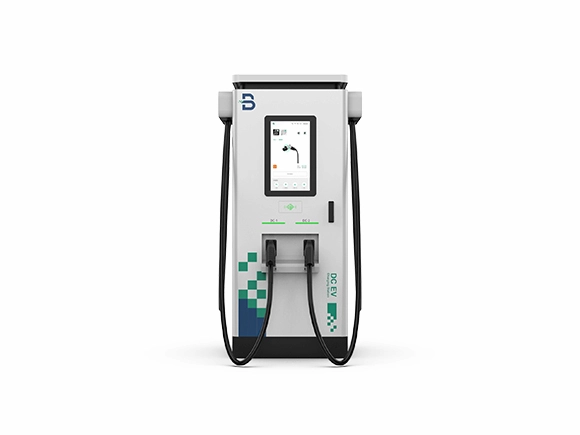














A estação de carregamento EVB DC EV é uma solução de ponta em tecnologia de carregamento para veículos elétricos, com refrigeração líquida avançada e capacidades que variam de 320 kW a 360 kW. Nossas estações de carregamento rápido para veículos elétricos são projetadas para velocidade e eficiência, oferecendo carregamento ultrarrápido, adicionando até 300 km de autonomia em apenas 10 minutos para veículos Tesla e outros veículos elétricos. A infraestrutura de carregamento para veículos elétricos desempenha um papel fundamental nas estações de carregamento para veículos elétricos em CC, incluindo o carregador rápido CC de 320 kW, o carregador CC de 360 kW e o carregador CC rápido para veículos elétricos. Para melhor gerenciamento de energia e confiabilidade, a estação também suporta configurações com carregadores rápidos CC com armazenamento de bateria, tornando-a uma opção pronta para o futuro para estações de carregamento rápido para veículos elétricos.
Eficiência do sistema ≥ 95%, baixo consumo de energia.
A tensão de entrada e a proteção contra curto-circuito garantem um carregamento rápido e seguro em CC.
Design de baixo ruído, ideal para soluções comerciais de carregamento de veículos elétricos.
Nossos carregadores de veículos elétricos incluem uma garantia limitada de cinco anos cobrindo todos os componentes principais; confie na confiabilidade e tranquilidade de longo prazo.
Dados ultranítidos, operação fácil mesmo sob sol ou luvas, além de tela pronta para anúncios.
Atualizações remotas de firmware aumentam a segurança, adicionam recursos, reduzem a manutenção no local e o tempo de inatividade.
Com um poderoso 500A corrente de carga, a Estação de Carregamento Rápido CC com Refrigeração Líquida EVB pode atingir velocidades de carregamento notáveis. Em apenas 10 minutos, nosso 360 kW O carregador rápido DC pode fornecer uma carga completa para um 300km Carro Tesla de alta autonomia. A tecnologia de carregamento para veículos elétricos da EVB permite um carregamento super rápido e excepcional, permitindo que os motoristas passem menos tempo esperando e mais tempo na estrada, tornando as viagens de longa distância mais rápidas, fáceis e convenientes do que nunca.


A tecnologia avançada de carregamento de VE da EVB apresenta resfriamento líquido inteligente, tornando o cabo de carregamento até 40% Mais leve e fino. Os proprietários de carros podem conectar o cabo ao veículo e observar o carregamento rápido da bateria. Os conectores de refrigeração líquida são projetados para durabilidade, capazes de suportar altas temperaturas, frio, umidade, poeira e pressão interna, garantindo confiabilidade durante longas sessões de carregamento. Este design aumenta a segurança e o desempenho em ambientes exigentes. O design do carregador rápido CC com armazenamento de bateria também permite que ele suporte pressão significativa para evitar vazamentos e manter sua integridade durante sessões de carregamento prolongadas. A estação de carregamento rápido CC é ideal para soluções comerciais de carregamento de veículos elétricos, integrando-se perfeitamente à infraestrutura moderna de carregamento de veículos elétricos.
O carregador CC refrigerado a líquido EVB e a solução ESS combinam tecnologia de carregamento eficiente para veículos elétricos com recursos flexíveis de armazenamento de energia da bateria, proporcionando excelente eficiência e confiabilidade no carregamento. Esta solução comercial de carregamento para veículos elétricos é adequada para diversos cenários, incluindo estações de carregamento públicas, aplicações industriais, transporte urbano e backup de emergência em infraestrutura, oferecendo soluções de energia confiáveis para diversas aplicações. É uma escolha inteligente e escalável para diversas necessidades energéticas.

| Modelos | BGDC60-D | BGDC90-D | BGDC120-D | |
|---|---|---|---|---|
| Item |  |  |  | |
| Descrição da estrutura | ||||
| Material da concha | Chapa metálica | |||
| Dimensão | 700*520*1800(C*P*E) | |||
| Peso | ≤500 kg | |||
| Método de instalação | Tipo de suporte de chão | |||
| Roteamento de cabos | Fiação de entrada inferior, fiação de saída superior | |||
| Comprimento do cabo | 5 M | |||
| Tomadas de Carregamento | Duplo(CCS1+CCS1) Duplo (CCS1+CHADEMO) Duplo(CCS2+GBT) Duplo(CHADEMO+CHADEMO) | Duplo(CCS2+CCS2) Duplo (CCS2+CHADEMO) Duplo(CHADEMO+GBT) | Duplo(CCS1+CCS2) Duplo(CCS1+GBT) Duplo(GBT+GBT) | |
| Autorização de Conectividade | RFID, Aplicativo | |||
| Tela | Tela de publicidade de 43 polegadas/luz LED | |||
| Especificação elétrica | ||||
| Tensão de entrada CA | CA380V±15%,3P+N+PEAC | |||
| Frequência de entrada | 50Hz/60Hz | |||
| Consumo | ≤40 W | |||
| Potência nominal | 60 kW | 90 kW | 120 kW | |
| Faixa de tensão de saída | CCS1/CCS2/GBT: 150 Vcc –1000 Vcc; CHADEMO: 150 Vcc –500 Vcc | |||
| Corrente de saída | CCS1/CCS2/GBT:0~250A;CHADEMO:0~125A | |||
| Eficiência | ≥95% | |||
| Fator de potência | ≥0,99(carga:100%) | |||
| Design funcional | ||||
| Interface do usuário | Botão de parada de emergência, indicador LED, passagem de cartão, tela sensível ao toque | |||
| Suportes de carregamento | CEI 61851-21-2:2021; CEI 61000-6-2:2019; EN61000-6-4:2019; CEI 61851-1:2019; EN 61851-23:2014; EN 61851-24:2014 | |||
| Comunicação | ||||
| OCPP | OCPP 1,6J | |||
| Interface de rede | Ethernet/4G | |||
| Condição ambiental | ||||
| Local de aplicação | Interior/Exterior | |||
| Latitude de trabalho | <2000m | |||
| Temperatura de trabalho | -30°C ~+50°C | |||
| Umidade de trabalho | 5%~95% | |||
| Nível de proteção | IP55 | |||
| Resfriamento Natural | Resfriamento por ar forçado | |||
| Tempo médio de produção (MTBF) | Garantia de 24 meses | |||
| Design de Segurança | Proteção contra sobretensão/subtensão, proteção contra sobrecarga, proteção contra vazamento de corrente, proteção de aterramento, proteção contra sobreaquecimento, proteção contra surtos de raios | |||
Da consulta à instalação, nossa equipe de especialistas garante uma solução abrangente de carregamento de VE adaptada às suas necessidades.
Copyright © 2025, EVB. Todos os direitos reservados. Desenvolvido por beny.